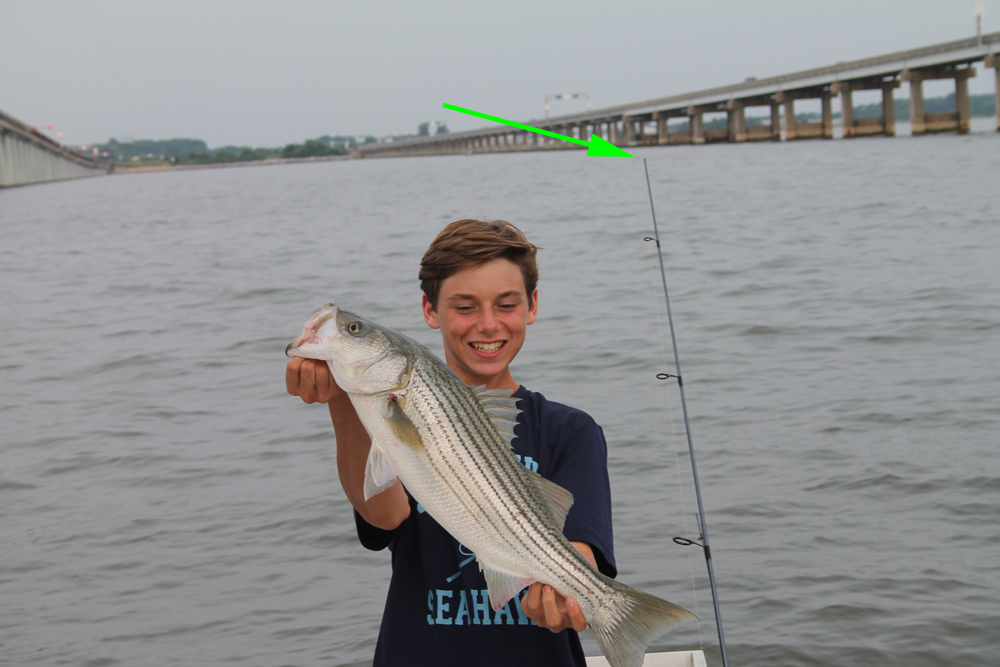I once tried to chunk for tuna with a rod I paid $20 for at K-mart, even as my buddy told me I was nuts. The rod broke, the fish got away, and I was forced to admit I’d made a spectacularly stupid mistake. After decades of destroying fishing tackle as though it was a hobby, hopefully, someone else will learn from my mistakes — and maybe it’ll be you.

- Don’t put hooks into the eyes of rod guides to secure them when you’re done fishing. This can scratch the smooth surface of the guide’s liner rings, which then causes line wear. Instead, if your rod doesn’t have a hook-keeper slide the hook into the foot of the guide, where the line never touches. Otherwise the next time you hook up to a big fish — snap!
- When you get a brand-spanking-new fly rod and walk into the front yard to try some practice-casting, first check for overhead power lines. Been there, done that — crack!
- Never lean a rod up against the wall, a car, or anything else that has a door nearby. Rods have a habit of sliding into the crack between the door and the door jam, and as soon as someone tries to open or close the door — crunch!
- Scale-set drags outdoors, only. Try it inside the house and if (when) the line breaks, the sudden release of tension will send your rod tip flying into the ceiling and/or overhead light fixtures — crash!
- Never let a rod touch the gunwale of your boat as you fight a fish. Rods are designed to distribute the stress they’re under along the length of the spine. If they can’t bend, they break — pow!
- Don’t swing fish over the side of the boat by raising your rod into a vertical position (commonly called high-sticking). Again, this doesn’t allow the rod to distribute the stress. Grabbing it half-way up when swinging a fish into the boat has the same result — D’oh!
- Never hand a rod from the dock down to the boat while holding it by the tip. Note; this is the worst kind of break since it often happens at or in your hand and can cause a puncture wound. That’s even more painful than having to admit you just made a spectacularly stupid mistake — ouch!
Unbelievably Bad Fishing Bait Blunders
Let’s say you’re uber-careful with all that fishing tackle, and everything is in great shape. Make one of these bait mistakes and the condition of your tackle won’t matter one bit.
- Never, ever thaw and then re-freeze anything. You wouldn’t take a fish fillet out of the freezer, let it sit on the counter and thaw, put it back into the freezer, thaw it again a week later, and then eat it, would you? Of course not, because multiple freezes and thaws change both the taste and texture of the meat. Same goes for bait.
- After applying bug repellent, if you bait up without first washing your hands you’re likely to go bite-less. The active ingredient in bug juice, DEET, is a scientifically-proven fish repellent. Only use bug repellent when you absolutely must (anyone who’s pulled the boat at dusk from Crisfield to Cape Charles knows there are times that it’s imperative,) and wash your hands thoroughly with soap any time you get near the stuff.
- Don’t throw away the bunker guts when you’re chumming for stripers. The stinky goo-ball is actually their favorite part of the fish, and you’ll get a lot more bites if you add it to your hook. But most of the guts are about as rugged as a jellyfish; you need to locate the one hard piece in that goo-ball (some call it the gizzard) and thread it onto the hook to get the guts to stay in place.
- Stop yourself from overloading the livewell. With spot this isn’t usually a huge deal (unless your livewell is a five-gallon bucket) but if you’re live-lining peanut bunker, it’s very easy to put too many baits into the well and then watch them all die off. Part of the problem is that one good throw with a cast net can bring dozens and dozens of peanut bunker into the boat and it’s hard to judge when you’ve kept too many. Try to keep yourself to no more than one livie per half-gallon of water, and you should be safe.
- Beware using one bucket to serve all purposes on a boat. The biggest issue here is using the same bucket for clean-ups and for bait, which could be a very big blunder. When you do the clean-up you probably put some soap into the bucket, and that soap is probably scented. Then, when you’re done cleaning up you probably dump the bucket and toss it in a corner. Fast-forward to your next fishing trip, when you cut some baits and drop them into the very same bucket – which is now tainted with soapy perfumes.
To learn about more mind-bendingly bad mistakes anglers make, check out “Rudow’s Guide to Mistakes Anglers Make,” available on Amazon.com.